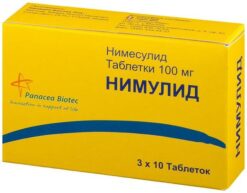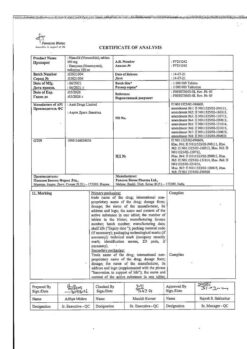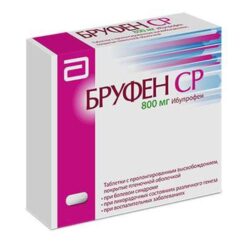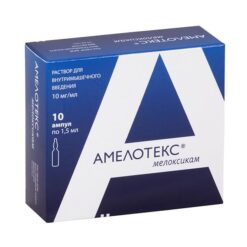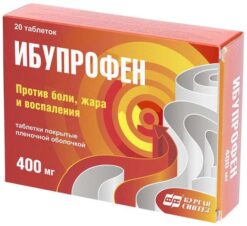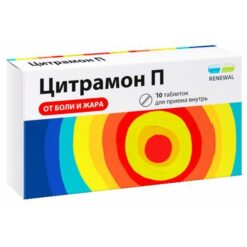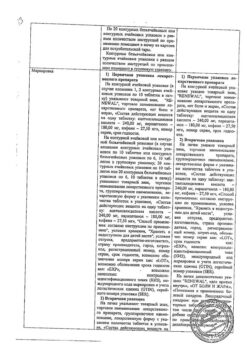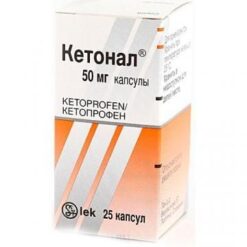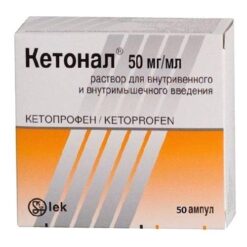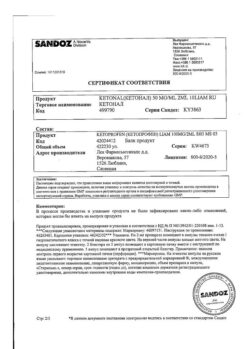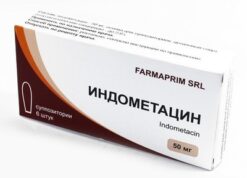No products in the cart.
Bystrumcaps, 200 mg capsules, 20 pcs.
€1.00
Out of stock
(E-mail when Stock is available)
Description
Pharmgroup:
NSAIDs.
Pharmic action:
Ketoprofen is a non-steroidal anti-inflammatory drug from the group of propionic acid derivatives. It has the following properties:
has an analgesic effect
has a antipyretic effect
shows anti-inflammatory effects
inhibits platelet aggregation
All the above properties are the result of the reduction of prostaglandin synthesis, by non-selective inhibition of cyclooxygenase activity of types 1 and 2.
Pharmacokinetics:
BYSTRUMCAPS 200 mg capsules contain granules with controlled-release active ingredient that are intended to be taken once daily.
The release of ketoprofen from the pellets occurs gradually in the intestinal tract.
Intake
After oral administration, ketoprofen is almost completely absorbed from the intestinal tract and has a “first pass” effect through the liver.
The maximum plasma concentration is reached 6 – 8 hours after oral administration of a dose of 200 mg. It does not accumulate in the body. Food does not affect the overall bioavailability of ketoprofen.
Distribution
Ketoprofen is 99% bound to plasma proteins. Ketoprofen penetrates into the synovial fluid, where it reaches higher concentrations than in plasma.
In a small amount penetrates through the placental barrier.
Metabolism
Biotransformation of ketoprofen proceeds in two main ways: by hydroxylation, as well as connection with glucuronic acid; the latter is the main way of metabolism.
Less than 1% of the dose of ketoprofen received is found unchanged in the urine, the rest are metabolites, of which 65 to 75% are metabolites of glucuronic acid.
Elimation
Excreted by the kidneys.
The half-life (T1/2) is about 8 hours.
In 5 days after ingestion, 70 to 90% of the dose is excreted in the urine and 1 to 8% in the feces.
In the elderly, the elimination period of ketoprofen is shorter and the T1/2 is longer, and in those with impaired renal function, the T1/2 is longer, depending on the degree of renal impairment.
Indications
Indications
symptomatic treatment of inflammatory and degenerative diseases of the musculoskeletal system (bursitis, synovitis, capsulitis, tendinitis, periarthritis);
articular syndrome (rheumatoid arthritis, osteoarthritis, ankylosing spondylitis), intended for symptomatic therapy, reducing pain and inflammation at the time of use, does not affect the progression of the disease;
pain in the lower back and spine (neuralgia, myalgia, sciatica, lumbago);
post-traumatic pain (uncomplicated injuries, in particular sports injuries, damage to ligaments and tendons, bruises);
postoperative pain;
pain with dysmenorrhea.
Pharmacological effect
Pharmacological effect
Pharmaceutical group:
NSAIDs.
Pharmaceutical action:
Ketoprofen is a non-steroidal anti-inflammatory drug from the group of propionic acid derivatives. Has the following properties:
has an analgesic effect
has an antipyretic effect
exhibits anti-inflammatory effect
inhibits platelet aggregation
All of the above properties are a consequence of the reduction of prostaglandin synthesis through non-selective inhibition of the activity of cyclooxygenases type 1 and 2.
Pharmacokinetics:
QUICKCAPS 200 mg capsules contain granules with controlled release of the active substance, which are intended for administration once a day.
The release of ketoprofen from granules occurs gradually in the intestinal tract.
Suction
After oral administration, ketoprofen is almost completely absorbed from the intestinal tract and has a “first pass” effect through the liver.
Maximum plasma concentrations are achieved 6 to 8 hours after oral administration of a dose of 200 mg. Does not accumulate in the body. Food does not affect the overall bioavailability of ketoprofen.
Distribution
Ketoprofen is 99% bound to plasma proteins. Ketoprofen penetrates into the synovial fluid, where it reaches a higher concentration than in plasma.
In small quantities it penetrates the placental barrier.
Metabolism
The biotransformation of ketoprofen occurs in two main ways: by hydroxylation, as well as by combining with glucuronic acid; the latter is the main metabolic route.
Less than 1% of the received dose of ketoprofen is found unchanged in the urine, the rest are metabolites, of which 65 – 75% are glucuronic acid metabolites.
Removal
Excreted by the kidneys.
The half-life (T1/2) is about 8 hours.
Within 5 days after administration, 70 – 90% of the dose is excreted in the urine and 1 – 8% in the feces.
In elderly people, the elimination period of ketoprofen decreases, and T1/2 increases, and in people with impaired renal function, T1/2 increases depending on the degree of renal impairment.
Special instructions
Special instructions
During treatment, monitoring of the peripheral blood picture and the functional state of the liver and kidneys is necessary.
If it is necessary to determine 17 – ketosteroids, the drug should be discontinued 48 hours before the study.
Taking ketoprofen can mask the signs of an infectious disease.
If renal or liver function is impaired, dose reduction and careful monitoring are necessary.
During the treatment period, care must be taken when driving vehicles and engaging in other potentially hazardous activities that require increased concentration and speed of psychomotor reactions.
To reduce the risk of developing adverse events from the gastrointestinal tract, the minimum effective dose should be used for as short a course as possible.
Active ingredient
Active ingredient
Ketoprofen
Composition
Composition
Active substance:
ketoprofen 200 mg
Excipients:
macrogol 4000,
ethylcellulose,
stearic acid,
ammonium methacrylate copolymer,
talc,
neutral granules (sugar and corn starch [3:1]).
Capsule shell:
gelatin, titanium dioxide.
Contraindications
Contraindications
Hypersensitivity to ketoprofen or to any component of the drug (including other NSAIDs);
peptic ulcer of the stomach and duodenum (exacerbation);
a history of bronchial asthma, rhinitis or urticaria caused by ketoprofen, acetylsalicylic acid or other NSAIDs;
ulcerative colitis (exacerbation);
Crohn’s disease;
diverticulitis;
peptic ulcer;
hemophilia and other blood clotting disorders;
active gastrointestinal, cerebrovascular and other bleeding (or suspected bleeding);
severe renal failure (creatinine clearance less than 30 ml/min);
progressive kidney disease;
severe liver failure or active liver disease;
condition after coronary artery bypass surgery;
confirmed hyperkalemia;
inflammatory bowel diseases;
children under 15 years of age;
pregnancy (III trimester), lactation period.
With caution: anemia, bronchial asthma, alcoholism, tobacco smoking, alcoholic cirrhosis of the liver, hyperbilirubinemia, liver failure, dehydration, sepsis, chronic heart failure, edema, arterial hypertension, blood diseases (including leukopenia), stomatitis, coronary heart disease, cerebrovascular diseases, dyslipidemia/hyperlipidemia, diabetes mellitus, peripheral artery disease, creatinine clearance less than 60 ml/min, history of ulcerative lesions of the gastrointestinal tract (GIT), presence of Helicobacter pylori infection, long-term use of NSAIDs, severe somatic diseases, concomitant use of oral glucocorticosteroids (GCS) (including prednisolone), anticoagulants (including warfarin), antiplatelet agents (including clopidogrel), selective serotonin reuptake inhibitors (including citalopram, fluoxetine, paroxetine, sertraline), old age, pregnancy (I, II trimester).
Side Effects
Side Effects
From the digestive system – NSAIDs – gastropathy, heartburn, nausea, vomiting, diarrhea, constipation, flatulence, loss of appetite, stomatitis, abdominal and epigastric pain, rarely – change in taste. With long-term use in large doses – ulceration of the gastrointestinal mucosa, gingival, hemorrhoidal bleeding, intestinal perforation.
From the urinary system – rarely: cystitis, urethritis, renal dysfunction, acute renal failure, interstitial nephritis, nephrotic syndrome, hematuria, edema (especially in patients with arterial hypertension).
From the liver: changes in transaminase activity may be observed, rarely – hepatitis.
From the nervous system: excitement, nervousness, drowsiness, depression, asthenia, headache, dizziness, sleep disturbance, insomnia, tinnitus, rarely – confusion or loss of consciousness, forgetfulness, migraine, peripheral neuropathy.
From the cardiovascular system: heart failure, increased blood pressure, rarely – tachycardia.
Hypersensitivity reactions: rhinitis, angioedema, anaphylactic shock, rash, itching, urticaria, asthmatic attack, especially in patients with hypersensitivity to acetylsalicylic acid, as well as to other drugs from the NSAID group.
Skin reactions: photosensitivity, alopecia, erythema multiforme, erythema multiforme, including Stevens-Johnson syndrome, toxic epidermal necrolysis (Lyell’s syndrome).
From the hematopoietic organs: anemia, leukopenia, thrombocytopenia, agranulocytosis, pancytopenia, rarely – hemolytic anemia.
From the senses: reversible toxic amblyopia, blurred vision or double vision, rarely – conjunctivitis, dry mucous membrane of the eye, eye pain, conjunctival hyperemia, hearing loss.
Other: increased sweating, rarely – hemoptysis, nosebleeds, myalgia, muscle twitching, shortness of breath, thirst, with prolonged use in large doses – vaginal bleeding.
If any side effects occur, you must immediately stop taking the drug.
Interaction
Interaction
Avoid simultaneous use with:
other NSAIDs (including salicylates in high doses), oral anticoagulants, heparin, ticlopidine – the risk of bleeding increases. If the use of ketoprofen is necessary, the patient’s condition should be carefully monitored;
lithium – risk of increased toxic levels of lithium in plasma. If necessary, during the simultaneous use of lithium and ketoprofen, as well as after its termination, the concentration of lithium in plasma should be carefully monitored;
methotrexate (at a dose of more than 15 mg/week) – the risk of hematotoxicity increases. The intervals before and after taking methotrexate should be at least 12 hours from taking ketoprofen.
Enhances the effect of anticoagulants, antiplatelet agents, fibrinolytics, ethanol, side effects of GCS and MCS, estrogens.
Increases plasma concentrations of verapamil and nifedipine.
Myelotoxic drugs increase the manifestations of hematotoxicity of the drug.
Reduces the hypotensive effect of beta blockers.
Increases the risk of nephrotoxic effects of beta blockers.
Increases the risk of nephrotoxicity from cyclosporine and tacrolimus, especially in elderly patients.
Reduces the contraceptive effectiveness of intrauterine devices. Increases the risk of bleeding when using thrombolytics.
Caution is required when used with:
diuretics and angiotensin-converting enzyme inhibitors – weakening of the diuretic and hypotensive effects and the risk of developing renal failure in patients with a deficiency of circulating blood volume;
pentoxifylline – increases the risk of bleeding;
zidovudine – increases the risk of anemia (affects reticulocytes with the development of anemia).
As with other NSAIDs, it is possible:
decreased effectiveness of uricosuric drugs;
increased risk of ulcer formation and the development of gastrointestinal bleeding and the development of renal dysfunction when taken together with GCS, ethanol, corticotropin;
increased risk of bleeding when administered concomitantly with cefoperazone, cefamandole and cefotetan;
increasing the hypoglycemic effect of insulin and oral hypoglycemic drugs (dose recalculation is necessary);
increased production of hydroxylated active metabolites by inducers of microsomal oxidation in the liver (phenytoin, ethanol, barbiturates, rifampicin, phenylbutazone, tricyclic antidepressants);
impaired platelet aggregation when co-administered with sodium valproate;
Antacids and cholestyramine reduce absorption.
Overdose
Overdose
An overdose of ketoprofen may cause symptoms of acute poisoning, such as: headache, dizziness, drowsiness, nausea, vomiting, diarrhea, pain in the epigastric region, decreased blood pressure, bronchospasm, bleeding from the gastrointestinal tract.
If you suspect an overdose, you should immediately consult a doctor.
Treatment in case of overdose: immediately stop using the drug.
If no more than 1 hour has passed since the drug overdose, gastric lavage with activated carbon at a dose of 60 – 100 g in adults, 1 – 2 g/kg body weight in children.
Symptomatic treatment.
Storage conditions
Storage conditions
In a dry place, protected from light, at a temperature of 15–25 °C
Shelf life
Shelf life
3 years
Manufacturer
Manufacturer
Valpharma S.P.A., San Marino Republic
Additional information
| Shelf life | 3 years |
|---|---|
| Conditions of storage | In a dry, light-protected place at 15-25 °C |
| Manufacturer | Valfarma, San Marino |
| Medication form | capsules |
| Brand | Valfarma |
Related products
Buy Bystrumcaps, 200 mg capsules, 20 pcs. with delivery to USA, UK, Europe and over 120 other countries.


